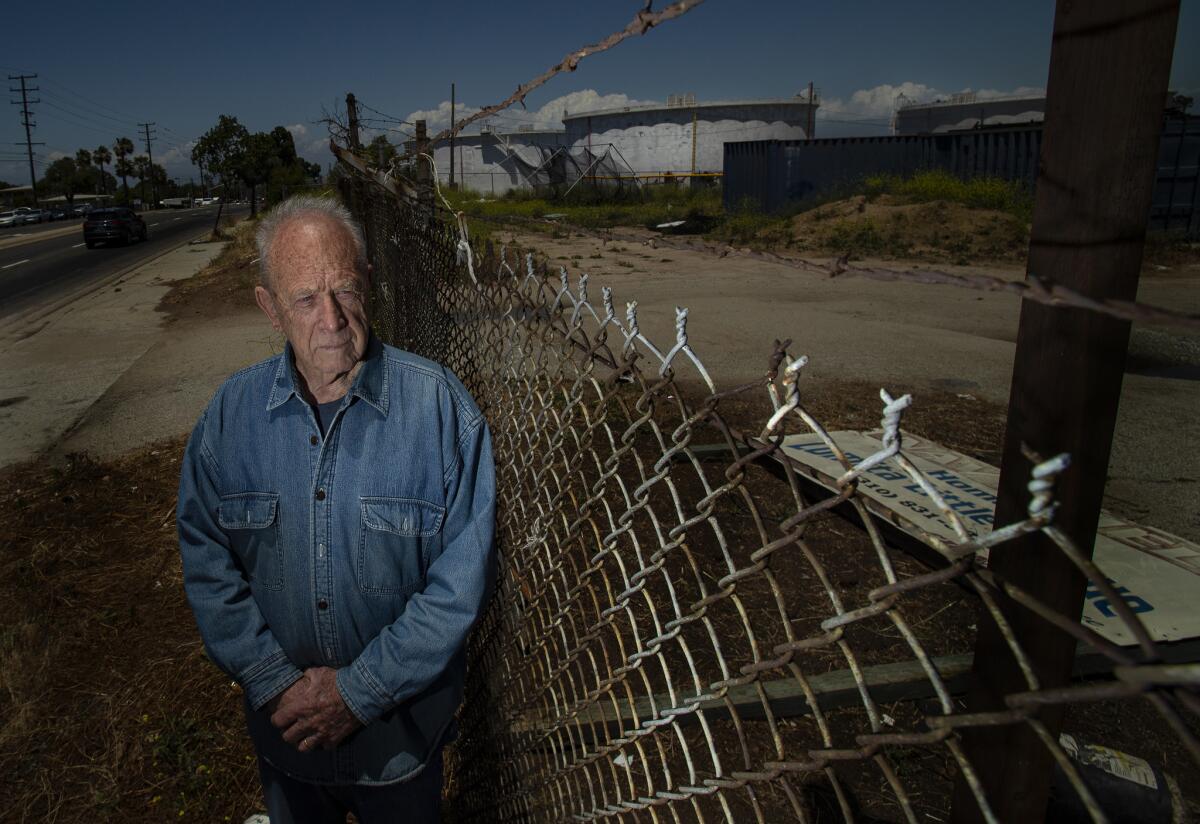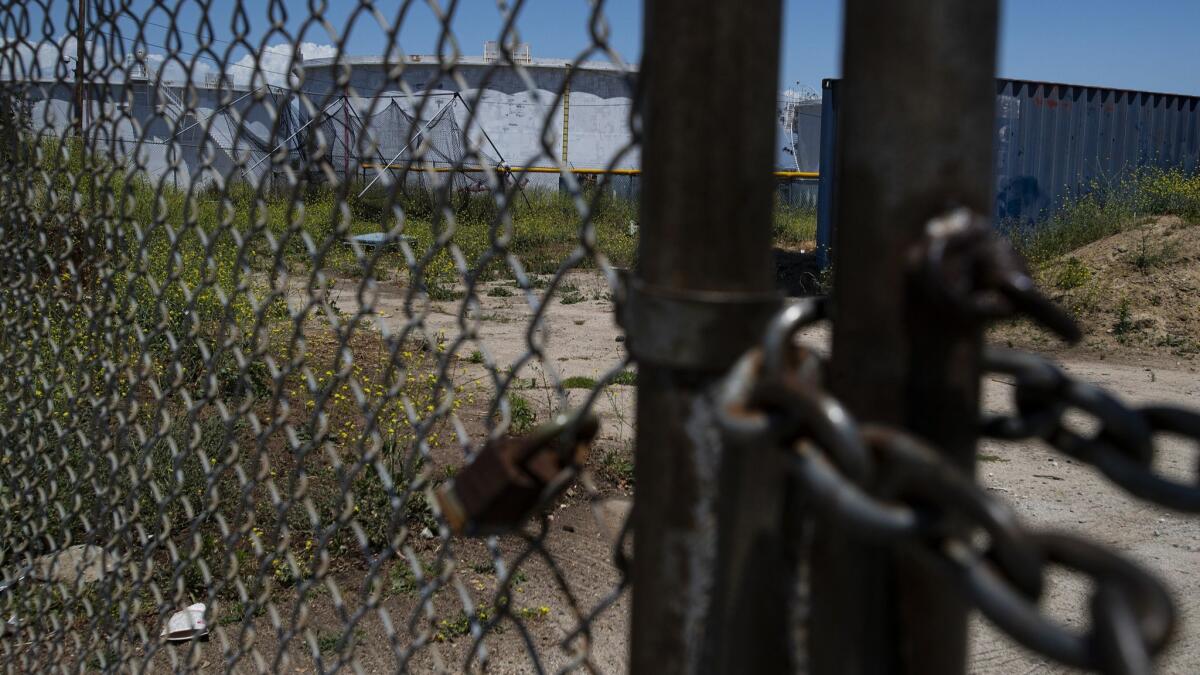Navy’s plans to revive a San Pedro fueling facility worry some residents

- Share via
A San Pedro fueling facility that has sat idle for several years could be reactivated and leased to a commercial operator under a plan put forward by the U.S. Navy, which owns the site.
The idea has alarmed some nearby residents who argue that the government should be shutting down local facilities that store combustible fuels, not reviving them in an area close to homes and schools. The sprawling site is close to a Phillips 66 refinery and down the street from a Rancho LPG Holdings butane storage facility.
“We could name it Devastation Highway instead of Gaffey Street,” said Chuck Hart, president of San Pedro Peninsula Homeowners United, arguing that an earthquake or terrorist attack could trigger disaster in the area. “It’s just too much in too little space.”
Under the plan, the Navy would lease the facility to a commercial operator, which would maintain and probably renovate the site.
“They would be responsible for keeping up the property and perhaps installing new tanks and new means of storing fuels as well as shipping fuels,” said Gregg Smith, a Navy spokesman. Under any agreement, “the Navy would be able to use those facilities to load ships with fuel when they’re needed.”
Doing so, Smith said, would “keep costs down for the taxpayer.”
The decision on whether to pursue the plan will fall to the Navy. The proposed move comes five years after the Gaffey Street facility, known as the Defense Fuel Support Point, went into “temporary closure” so that it could be either reopened or shuttered depending on future needs, according to the Navy.
Some of it has been shut down permanently: Underground tanks at the San Pedro site were disconnected and filled with a special kind of concrete.
But other equipment and facilities remain, including buildings, pipelines and three above-ground storage tanks.
The Navy indicated that any company that leased the site would probably need to upgrade the existing facilities, but development would be limited to “previously disturbed areas.” The site spans more than 300 acres and is also home to native plants and habitat for the endangered Palos Verdes blue butterfly.
Residents had hoped that the sprawling property could be put to another use for the community.
The news that the Navy is instead seeking to lease it out and reinstate its use for fueling operations disappointed Janet Schaaf-Gunter, another member of San Pedro Peninsula Homeowners United.

“It makes no sense to congregate the most serious explosives ... in this one little nucleus of opportunity,” said Schaaf-Gunter, who has long raised concerns about the risk of a catastrophic explosion at the Rancho LPG storage facility.
The Navy site on Gaffey Street is crossed by the Palos Verdes Fault Zone and parts of the property are in a liquefaction zone, according to a draft environmental assessment prepared for the Navy.
Barbara Sattler, a Rancho Palos Verdes resident, said she was not reassured by the plan, calling it “a high-hazard situation in the middle of a residential area.”
And Caney Arnold, a board member with the nearby Harbor City Neighborhood Council, questioned the need to resume operations there at all.
“Why are we doing this in the first place?” Arnold asked. “Why don’t we use the land for something else?”
Smith, the Navy spokesman, said that since the Gaffey Street facility went idle, the Navy had determined that it needed more fueling capacity in Southern California as defense forces are being shifted from the Atlantic to the Pacific.
In response to concerns about safety, Smith said the site would comply with all federal, state and local regulations.
“All three sites [the Navy facility, the Phillips 66 refinery and the Rancho LPG site] have operated in close proximity to each other for over 45 years without incident,” he said.
The Navy is putting forward the idea as Los Angeles politicians have vowed to scale back on fossil fuels and clamp down on industrial emissions under their own “Green New Deal” plan.

Mayor Eric Garcetti and City Councilman Joe Buscaino, who represents the San Pedro area, both oppose the Navy proposal.
“We have existing infrastructure in place to support the Navy’s critical fueling operations — and as Los Angeles moves toward a clean-energy economy, it is unnecessary to build new petroleum projects in the region,” Garcetti spokeswoman Anna Bahr said in a statement.
In a letter, Buscaino emphasized that schools and after-school programs were close to the facility and cited the “plausible inherent dangers of stored materials in close proximity to residential zones.”
Jacob Haik, Buscaino’s deputy chief of staff, said one of their chief concerns is that the plan leaves undefined exactly what kind of new equipment could be added to the site.
In the past, from 4 million to 12 million barrels of fuel have been shipped annually to or from the San Pedro facility and a connected terminal at the Port of Long Beach, according to the environmental assessment.
It is unclear how much fuel would go through the facility in the future, but for the environmental analysis, the new plan estimated it could peak at 30 million barrels annually.
Community members have until Monday to submit comments on the plan. After that, the Navy will prepare a final version of its environmental analysis.
If the Navy finds “no significant impact” from the proposed move, it could move forward with a lease as soon as next year, Smith said.
Twitter: @AlpertReyes
More to Read
Sign up for Essential California
The most important California stories and recommendations in your inbox every morning.
You may occasionally receive promotional content from the Los Angeles Times.











